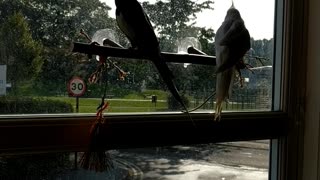Premium Only Content

Flying fox bat adorably clings to its mother in the rainforest
Large flying fox bats, also known as large fruit bats are one of the world's largest bats, and one of 173 species of bat found in Papua New Guinea. PNG is home to some of the world's most diverse and fascinating wildlife. It is also home to the world's largest remaining tracts of rainforest. This climate and environment is perfect for flying foxes and they are abundant in many of the forested areas of PNG.
Flying foxes are one of the group of large bats known as "mega bats". With a wingspan of more than 1m (3 feet), large colonies of flying foxes can darken the sky when a large group takes flight at the same time. They roost in trees in great numbers, squealing and calling as they communicate with each other and the sound is deafening. They are often found in colonies that number in the tens of thousands.
This baby flying fox clings to its mother for warmth and comfort, and it also relies on her for food for several months. A female will give birth to only one baby each year. The baby will cling to its mother for the first month, even as she goes out on search of food. As it becomes larger and stronger, she will leave it in the tree on its own for short periods as she forages for food then returns. Since bats are mammals, the baby will drink milk from the mother until it is old enough to eat fruit.
This baby is large enough to hang on the tree with its own feet and it is far too large now for her to carry as she flies.
Aptly named, the flying fox has a small face that closely resembles a fox or small dog. Dog-like ears and large eyes make their faces irresistible. Flying foxes are more than just cute, they are a true wonder of adaptation, being the only mammal on the planet that is capable of flight. Large leathery wings and a powerful heart make flying possible for these animals. Their resting heart rate ranges between 100-400 beats per minute. Their digestion is also remarkable as the time between eating and food and excretion of that meal can be as little as 12 minutes.
Flying foxes are not threatened species, but habitat destruction, entanglement in orchard netting, and consumption of the bats by humans is causing a population decline. Flying foxes carry three viruses that are potentially transmissible to humans and the consumption of bats can be potentially fatal. Left alone, flying foxes pose no threat to humans and will not interfere in any way with our way of life.
-
 2:03
2:03
WildCreatures
8 days ago $0.51 earnedBreathtakingly beautiful farmland as you've never seen it
2.33K9 -
 0:11
0:11
Serfontein
6 years ago $5.59 earnedMother squirrely & baby adorably snack on piece of lettuce
1.45K2 -
 0:43
0:43
CoverVideo
5 years ago $0.21 earnedCheeky Monkey Cannot Escape Its Mother
1.9K1 -
 1:20
1:20
ViralHog
5 years ago $14.69 earnedBaby Raccoon Scales Home Waiting for Its Mother
44.4K2 -
 4:39
4:39
ViralHog
5 years ago $142.59 earnedBaby Koala Mistakes Doggy For Its Mother
579K11 -
 0:11
0:11
arcticfoxdaily
5 years ago $8.41 earnedArctic fox adorably enjoys belly rubs
30.9K1 -
 0:53
0:53
ViralHog
5 years agoFlying Away from Singing Suitor
119 -
 0:39
0:39
MaxtheMoluccan
5 years ago $14.06 earnedMoluccan Cockatoo adorably meets Santa Claus
6.01K3 -
 0:31
0:31
NataliaCara
5 years agoRescued manatees adorably kiss each other
5.97K4 -
 0:14
0:14
rumblestaff
5 years agoPenguins adorably attempt to chase down bubbles
3131